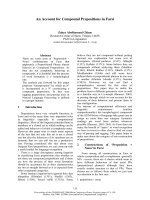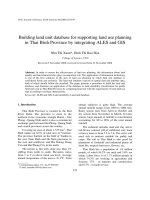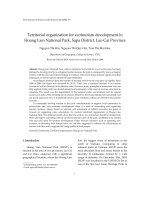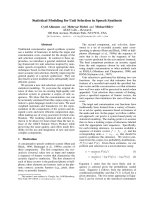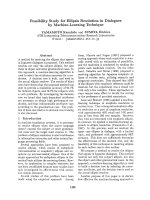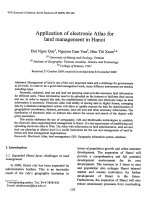Báo cáo " Building a GIS database for ecotourism development in Ba Vi District, Ha Tay Province, Vietnam " potx
Bạn đang xem bản rút gọn của tài liệu. Xem và tải ngay bản đầy đủ của tài liệu tại đây (494.69 KB, 6 trang )
VNUJournalofScience,EarthSciences23(2007)146‐151
146
BuildingaGISdatabaseforecotourismdevelopment
inBaViDistrict,HaTayProvince,Vietnam
NguyenDinhMinh*
CollegeofScience,VNU
Received08July2007
Abstract.Ecotourismisaconceptandafastgrowingsegmentof thetourismindustryworldwide.
It plays an increasingly important role in the socio‐economic development of many districts and
provincesinVietnam. Therefore, itneeds to bewellplanned andmanaged withtheaid of spatial
informationtechnologies suchas RemoteSensing (RS),Geographic Information System (GIS) and
Global Positioning System (GPS) . This pa per presents the resul ts of building a GIS databas e fo r
ecotourismdevelopmentinBaVi,alargelegendarymountainousdistrictofHaTayProvincebased
onfieldand deskinvestigations.The created databaseconsistsofspatialand attributive data files
relatedtonaturalandculturalresourcesinBaVistoredinastandardformatofArcViewGISthat
canandshouldbeeffectivelyretrieved,analyzedandupda tedtogenerateusefulinformationinthe
formofmaps,tables and charts to support ecotourismplanningand
managementactivitiesinthe
districtforsustainabledevelopment.
Keywords:ArcView;GIS;Database;Ecotourism.
1.Introduction
*
In recent years, ecotourism has become a
fast growing segment of the world tourism
industry. It can be differentiated from
traditional tourism in that it not only attempts
tominimizetheenvironmentaleffectoftourism,
but also has the goal that local communities
and the physical environment will actually
benefit
from tourism. In its ideal form,
ecotourism is a philosophy, an activity, a
development policy all at the same time [8].
AccordingtotheofficialdefinitionoftheWorld
Conservation Union (IUCN), ecotourism is
ʺenvironmentally responsible travel and
_______
*
Tel.:84‐4‐5112474.
E‐mail:
visitationtorelativelyundisturbednaturalareas,
in order to enjoy and appreciate nature
(includinganyaccompanyingculturalfeatures‐
both past and present), that promotes
conservation, has low visitor impact and
provides for beneficially active socio‐economic
involvement of local populationsʺ [2].
However, for Third World countries,
ecotourism, according to Pleumarom [9],
can
become an ecological and economic trap (bad
loan,oversupply, ).That iswhyit needstobe
wellplannedandmanaged.
In Vietnam, ecotourism has captured the
attention of researchers, investors, and
authorities in an effort to boost economic
development and environmental protection
throughout the country. It is defined
as a type
NguyenDinhMinh /VNUJournalofScience,EarthSciences23(2007)146‐151
147
of tourism based on nature and indigenous
culture,whichnecessarilyinclu desenviro nmental
educat ion,andcontributestoconservationefforts
and sustainable development with the active
involvement of the local community [6] . As a
tropical, developingcountry inthe Asia Pacific
region,and anewmemberoftheWorld Trade
Organization,Vietnam
has agreatpotentialfor
ecotourism dev elo pm ent . However, the data
andinformationonecotourisminVietnamisstill
very limited. To fill this gap and help furt her
developmentofecotourisminthecountry,more
studies should be carried out and their results
shouldbewidelydisseminatedthroughdifferent
channels. This call
forthe applicationof spatial
information technologies such as remote
sensing, GIS and GPS to develop databases to
supportecotourismplanningand management
atnational,provincialanddistrictlevels.
This paper describes the research effort to
buildaGISdatabaseforecotourismdevelopment
atthe districtlevel withspecial reference
to Ba
ViDistrict,HaTayProvinceinnorthernVietnam,
focusing on its local nature and culture. It is
believedthattheresearchresultswillserveasa
soundbasisforBaVi’secotourismplanningand
management, and the experience from Ba Vi
canbeappliedtootherdistrictsinthe
country.
2.Studyarea
The study area is the largest and
northernmost district of Ha Tay Province. It is
locatedabout60kmwestofHanoiandbordered
withprovincesofPhuTho,VinhPhucandHoa
Binh (Fig. 1). Ba Vi is a forested district with
threemountain peaks:
DinhVua (1298m),Tan
Vien(1227m)andNgocHoa(1180m)surrounded
bylowundulatedhills,andwatersheds.
TherocktypesinBaViincludePrecambrian,
Paleozoic, Mesozoic, and Kainozoic rocks. The
soil typescomprise redyellow,brown red and
yellow feralite soils, red brown basaltic soils,
alluvialsoils,
valleysoils,andgleysoils.
Ba Vi
Phu Tho
Vinh Phuc
Hoa Binh
Hanoi
Ha Tay
N
EW
S
10 0 10 Km
Province
District
Fig.1.Locationofthestudyarea.
NguyenDinhMinh /VNUJournalofScience,EarthSciences23(2007)146‐151
148
The climate is tropical with hot humid
summer andcold dry winter. It isaltitudinally
differentiated into microclimatic zones,
particularlyfavorableforsummertourism.The
mean annual temperature is about 23‐25
0
C in
theareasbelow100m,20
0
C at500m,and18
0
C
at 1000 melevations. The mean annual rainfall
is2000‐2500mm.
Water resources are represented by Da
River, Red River, other small rivers, streams,
lakes and reservoirs. Stream density varies
from0,1‐1,5km/km
2
,tendingtoincreaseasone
goes farther from the Ba Vi peak. Many small
streams have been embanked to serve
agricultureandtourism.
Vegetation resources comprise natural
forest, planted forest, shrub, orchards, rice and
grazing fields. There are three types of forest
distributed on the Ba Vi Mountain: tropical
humid
evergreen closed forest, subtropical
humidevergreen closedforest, andsubtropical
mixed broadleaf‐needleleaf forest. The Ba Vi
National Park (BVNP) was established in 1991
withanareaof7377hatoconservebiodiversity.
The natural forest is mainly distributed at
elevations above 600 m. Rare and precious
species consist of
Calocedrus marcrolepis Kurz,
Podocarpus neriifolius, Madhuca pasquieri,
Michelia baviensis, Cyathea gygantea, Tacca
chandrieri. Endemic species are Caryodaphnopsis
baviensis,Litseabaviensi.
BaViDistrictconsistsofatownshipand31
communeswithatotalareaofabout440.34km
2
,
andapopulationofabout250,000people.Kinh,
Muong,andDaoarethreemajorethnic groups
living in th e area. Their main economic
activities are agriculture, forestry and tourism.
According to IFPRI (International Food Policy
Research Institute) and IDS (Institute for
DevelopmentStudies)[5],BaViisapoordistrict
with 40‐50% of people live below the poverty
line. It is believed that ec ot o uri sm activity can
contribute actively to povert y reduction and
sustainabledevelo pm e nt inBaViDistrict.
According to statistics, the number of
touristscomingtoBaVihasbeenincreasing[1].
However, the number of international tourists
is still limited, only about 1%. This may be
attributedtounsuitablevisitconditions,lackof
data, information, andlimitedadvertising. The
lack of spatial and non‐spatial data necessary
forecotourismplanningandmanagementinBa
Vicanbefoundatboththedistrictdepartments
andthe national park management
board. This
studyisanattempttodealwithsuchaproblem
by creatingaGISdatabase thatallowsefficient
ecotourism related data input, management,
analysisandoutput.
3.Dataandmethods
3.1.Data
ThedatausedtobuildtheGISdatabasefor
ecotourism development in Ba Vi come from
different sources includingexisting maps,atlas
[7], research reports, newspapers, magazines,
journals,brochures,travelguides,websitesand
ground survey in the form of text, maps,
imagery and pictures. They can be primary or
secondary, digital or analogue that depict
locations,shape,extent andattributesofnatural
and cultural resources in the
district such as
mountains, rivers, springs, falls, lakes,
reservoirs,national park,forests, gardens,road
network, schoolsand existingecotourism sites.
They constitute the key themes and attribute
tablesinthedesignedArcViewGISdatabase.
3.2.Methods
TheGISdatabasedevelopmentrequiredthe
use of different hardware and software. The
hardware
used includesPC, laptop computers,
scanners, digitizers, printers, GPS receiver and
digitalcamera.TheGIS,spreadsheetanddatabase
management software packages including
MapInfo,ArcView,Idrisi,MS Excel,MSAccess
were used to create the required themes and
NguyenDinhMinh /VNUJournalofScience,EarthSciences23(2007)146‐151
149
tablesintheArcViewGISenvironment.
ArcViewGISbythe EnvironmentalSystems
Research Institute (ESRI) was adopted for this
research because of its popularity, ease of
installation, ease of use, power, flexibility,
intuitivityandextendability.Thesoftwareisthe
premier solution for desktop GIS analysis and
map presentation. It lets
one work with maps,
tables,andchartsallinasingleapplication[3,4].
The procedure for developing the GIS
ecotourism database for Ba Vi in ArcView
includes data collection, data input, data
management,dataanalysisanddataoutput.
Thedata collectioninvolvedsurveyingand
collecting available data and primary data
in
and outside thedistrict. This work wascarried
out in the office and in th e field. The Internet
searchengineswereemployed.Duringthefield
investigations, hand held GPS was used to
collectspatialdataoffeaturesofinterestandfor
geo‐referencing and updating existing digital
maps. Still
pictures were taken using digital
camera.
During the data input, methods of manual
digitizing, scanning, keyboard entry and data
conversion were employed. Analogue maps
were scanned, digitized using Microstation,
MapInfo,andArcView.GPSdata wereentered
inExcelandimpo rtedtocreateArcViewthemes.
The data in MapInfo format were converted
intoArcViewformat usingUniversalTranslator.
The data management was performed to
ensureefficientstorageofdatafilesondifferent
media such as hard disk, CD, DVD and USB
and in the right map projection. This involved
renaming, copying, deleting and saving data
files. The data files were analyzed by
location
or attributeto create BaVi specificthemes and
tables. Finally, the output from the database
wasmadeintheformofhardcopies,electronic
copies using the above mentioned hardware
andsoftwaretools.
4.Resultsanddiscussion
Asa mainresult, anArcViewGIS database
was developed which contains
spatial and
attribute data files of natural and cultural
resources in Ba Vi. The spatial data include
feature themes (e.g., points, lines, polygons)
and image themes (e.g., satellite images, and
groundphotos)(Fig.2,3,4,and5).
The themes and associated tables in the
databaseallowonetoview,
query,andanalyze
ecotourism in Ba Vi. For example, different
ArcView GIS project files can be created
containing one or more views with multiple
themes that can be displayed, queried, and
editedtoallowforvariousspatialinterpretations
oftheBaViecotourismopportunit ies.
Fig.2.Exampleoffeaturethemesinthedatabase.
NguyenDinhMinh /VNUJournalofScience,EarthSciences23(2007)146‐151
150
Fig.3.Anattributetableinthedatabase.
Fig.4.Asatelliteimagetheme inthedatabase.
Fig.5.AgroundphotooftreefernsinBaViNationalPark.
Thedatabasemeetstheneedsofspatialand
attribute analysis to derive useful qualitative
andquantitative informationaboutlocationsof
ecotourism sites, best or nearest lodges,
optimum plan for sight seeing and shortest
routeingettingtoecotourismdestinations.The
database and its products can be used for
efficientmarketing ofecotourism activitiesand
destinationsinthedistrict.
In other words, from the GIS database,
various outputs including maps, graphics,
pictures are generated to support education,
planning, management and promotion of
ecotourism in Ba Vi. The ArcView maps
NguyenDinhMinh /VNUJournalofScience,EarthSciences23(2007)146‐151
151
generated from the GISdatabase can showthe
extent of Ba Vi District, as well as hydrology,
roadsandmajorecotourismsitesinandaround
BVNP, including Khoang Xanh, Ao Vua, Thac
Da, BangTa‐DamLong,NgocNhistorkgarden,
Suoi Hai reservoir. Ecotourism routes can be
developedto
connectBVNP,SuoiHaireservoir,
Ao Vua, Khoang Xanh, Dam Long or can start
from VNUʹs Ba Vi Experimental Center for
Ecological and Environmental Education
(BVECEEE)toBaVipeaks;toDa Chong,Minh
Quang;and XomQuyt amianextractionsite.
Specific activities or products that can be
developed in
Ba Vi include destination lodge
(ecolodgesorresorts),freshwaterfishing,forest
walk, mountainbiking,hiking,natureobservation,
birdwatchingandwildlifeviewing,attendinga
festival, a cultural event, visiting an ethnic
minorityvillage,ahistoricsite.
The created database is a powerful tool to
explorelocalecologicalfactors,admire,and
enjoy
thenaturalbeauty,biodiversityaswellascultural
valuesoftheKinh,MuongandDaopeopleliving
in the area. This digital source of data and
information is essential to understanding and
conservingtheuniquecharacterofBaViDistrict.
It is a well structured database, which can be
easily
updated,andexpandedtomeetthefuture
needsofecotourismdevelopmentinBaVi.
5.Conclusionsandrecommendations
BaViDistrict,HaTayProvinceinnorthern
Vietnamisaforested areawithgreatecotourism
potential. An ArcView GIS database has been
developed for ecotourism development in the
district using different
data sources, popular
GIS and othersoftware packages. It consists of
spatialandattributivedatafilesoflocalnatural
andculturalresources.
The created GIS database is useful in
thematic mapping, tabulating and charting to
support education, planning, management and
promotionofecotourisminBaVi.Itisatoolto
raiseawarenessandadvertiseBaViecotourism
productsmore,fasterandbetter.
The database can and should be used for
furtherstudiesinBaViecotourismusingremote
sensing, GIS and GPS. It can be easily and
quickly updated and expanded as new data
becomeavailable.Itisalsodesirable
toupgrade
with sound data to form a multimedia GIS
ecotourismdatabase.
Finally, the experience of GIS database
development for BaViDistrict canand should
be applied to other districts in the country to
bettercapture,store,manage,analyzeanddisplay
dataforsustainableecotourismdevelopment.
References
[1] BaViDistrict’sPeopleCommittee,Reportonthe
performance of tourism business, Ba Vi, 2004 (in
Vietnamese).
[2] H. Ceballos‐Lascurain, Tourism, ecotourism, and
protected areas, IUCN Protected Areas
Programme,IUCNGland,1996.
[3] ESRI, Using ArcView GIS, Redlands, CA, US A,
1996.
[4] ESRI, Ar cView GIS‐the Ge ogr aphic information
systemforeveryone.Redlands,CA,USA,2000.
[5] IFPRIandIDS,PovertyandinequalityinVietnam:
Spatial patterns and geographic determinants,
Hanoi,2003.
[6] A. Koeman, The economics of protected areas
andtheroleofecotourismintheirmanagement:
the case of Vietnam, Second Regional Forum for
Southeast Asiaof
theIUCN World Commissionfor
ProtectedAreas,Pakse,LaosPDR,1999.
[7] Ministry of Science, Technology and
Environment (MOSTE), Atlas Vietnam: Natural
resources and Environment, Hanoi, 2000 (in
Vietnamese).
[8] J. Mock and O. Kimberley, Survey of Ecotourism
Potential in Pakis tanʹs Biodiversity, A consultancy
reportforIUCN,Islamabad,
Pakistan,1996.
[9] A. Pleumarom, Eco‐tourism: An ecological and
economic trap for Third World Countries, 5
th
meetingoftheConferenceofPartiestotheConvention
onBiologicalDiversity,Singapore,1999.

